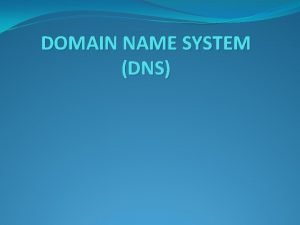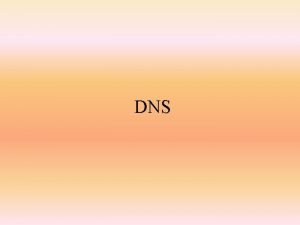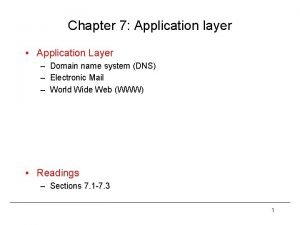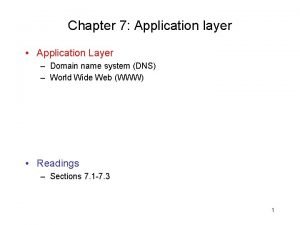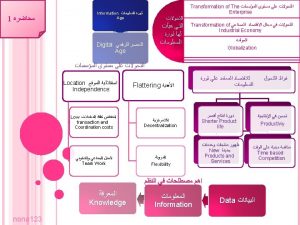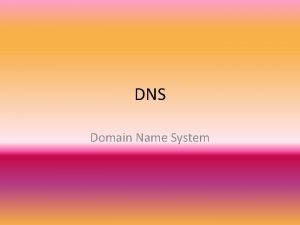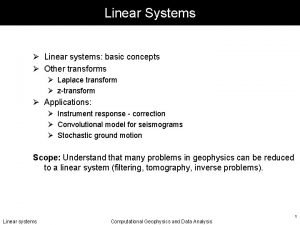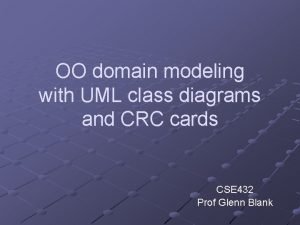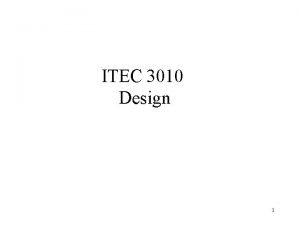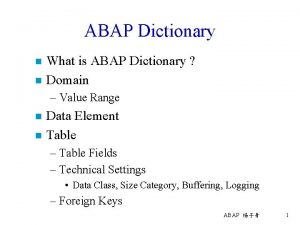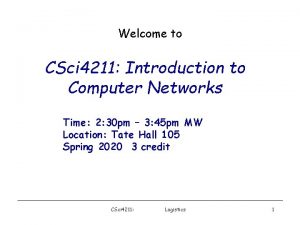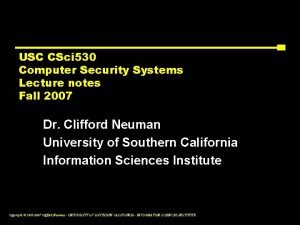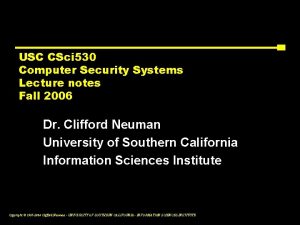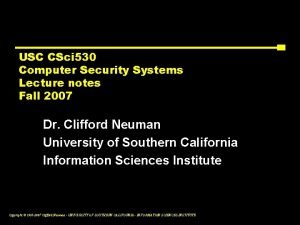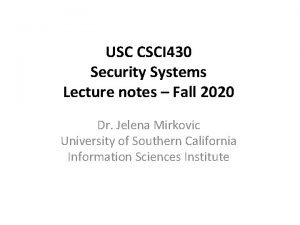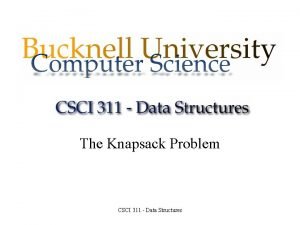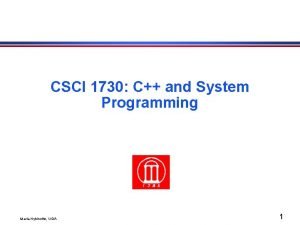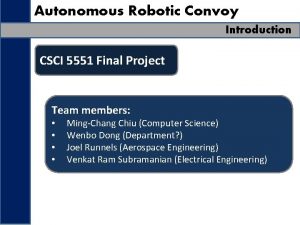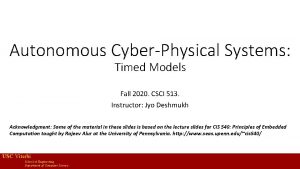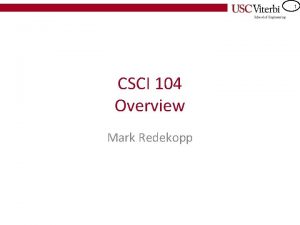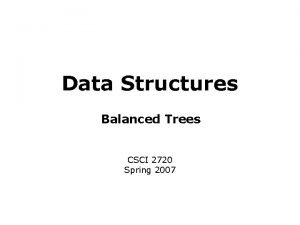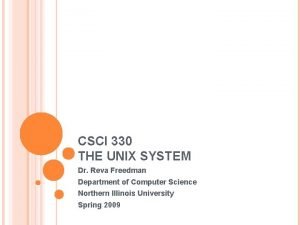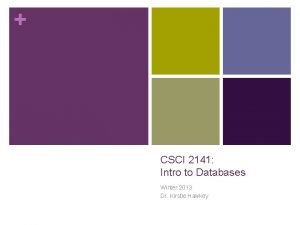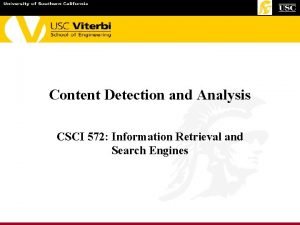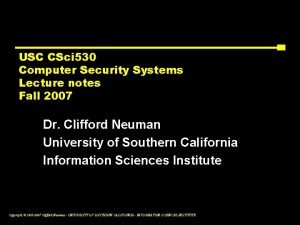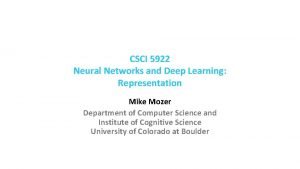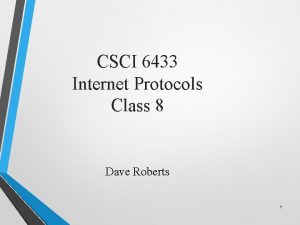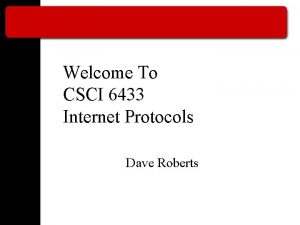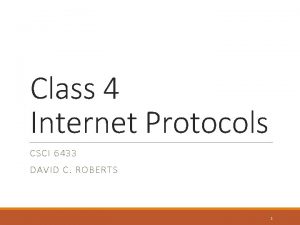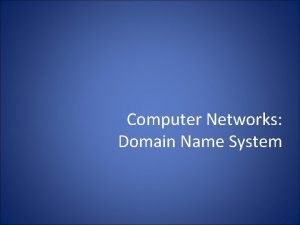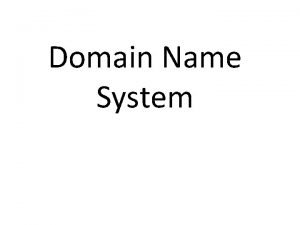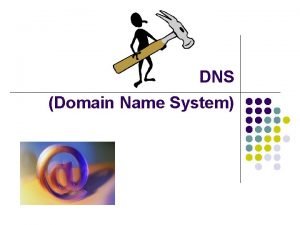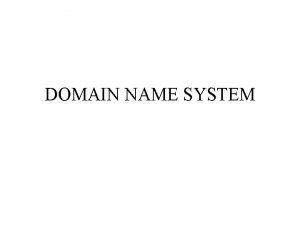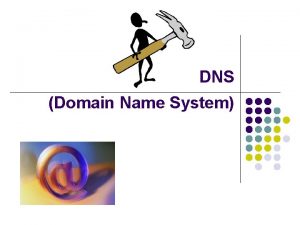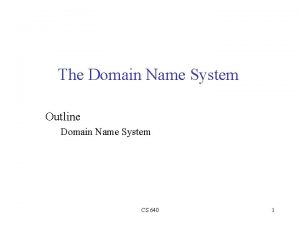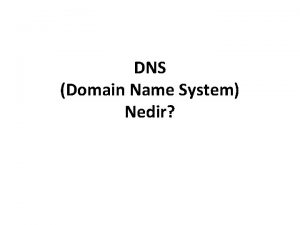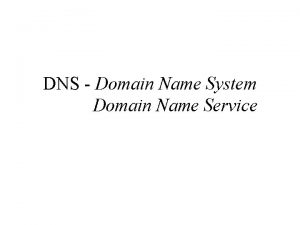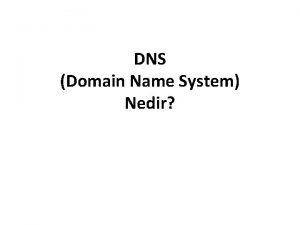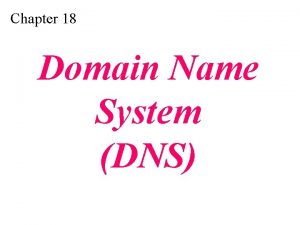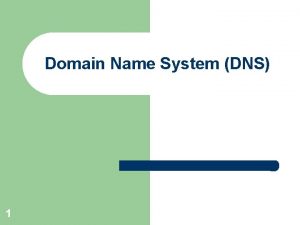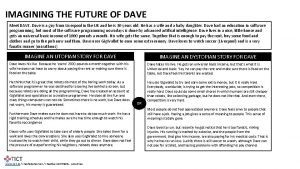DOMAIN NAME SYSTEM Class 9 CSCI 6433 Dave
































































- Slides: 64

DOMAIN NAME SYSTEM Class 9 CSCI 6433 Dave Roberts Entire contents copyright 2014, David C. Roberts, all rights reserved

2 Agenda • Name systems • DNS • DHCP

3 NAME SYSTEMS

4 Why Name Systems • Computers are happy with numbers • Important reasons why IP addresses have numbers • However, humans like to deal with names • Especially in the case of IPv 6 • Name systems can provide names for humans to deal with • But there’s another reason too—names can be made more persistent than IP addresses

5 Internet Name Spaces • MAC Addresses • Identities of NICs • Unique across a LAN, at least • Usually 48 bits • IP Addresses • Routable address of a host • Can change frequently • 32 or 128 bits • Unique across the Internet • Domain Names • English language names • Generally tied to an activity of people • Changes slowly, may have years of duration

6 DOMAIN NAME SYSTEM

7 In The Beginning—Host Name Mechanism • Text file called hosts • Looked like this: # Host Database # This file should contain the addresses and aliases # for local hosts that share this file. # # Each line should take the form: # <address> <host name> # 127. 0. 0. 1 localhost 128. 164. 1. 16 www. gwu. com 74. 220. 25. 150 www. webmarketingadvantage. com 198. 175. 98. 64 ftp. intel. com • This is no longer used. • Why not?

8 Internet with Names, without DNS

9 With DNS

10 Basic Name System Functions • Name space: rules how names are structured and used • Name registration: a method for linking specific names to specific devices so that names are unique across the entire Internet • Name resolution: mechanism for translating a symbolic name into an IP address

11 Principal RFCs for DNS

12 Goals for DNS • Global, scalable, consistent name space • Local control over local resources • Distributed design to avoid bottlenecks • Application universality • Support for multiple underlying protocols • Hardware universality

13 The Approach • As the Internet grew, there were predictions that it would collapse because of the growth of DNS and the large amount of name-lookup traffic • This is one of the most centralized features of the Internet • The approach used was to adopt a hierarchical name system, so that as the name space grew it could be subdivided and reside on multiple servers • The use of caching throughout the DNS has greatly reduced the amount of traffic to primary servers • The system has proved to be quite robust

14 What DNS Does • Designates an authoritative name server for each domain • Authoritative name server is responsible for its designated domains • For example, servers for webmarketingadvantage. com are ns. intersessions. com and ns 2. intersessions. com • Some types of DNS records: • A or AAAA—IP address • NS—name server • MX—mail exchanger

15 Domain Name Space • Highest level domain is on the right • Test. ncww. us • Highest level domain is. us • Then ncww • Then test • Symbols used follow the LDH rule—letters, digits, hyphen • Domains are interpreted as case-independent • Hostname—a domain name associated with an IP address Source: Wikipedia

16 Domain Name Space

17 DNS Functions

18 Address Resolution • DNS Resolvers query TLD servers to find domain servers 1. Network host has initial cache (called hints) with addresses of known root servers 2. Query to a root server finds server for the TLD 3. Query to TLD server finds DNS server authoritative for the second-level domain 4. This continues until the final step returns IP address of the host Question: what can be done to reduce the message traffic associated with the DNS process?

19 How It Works Source: Wikipedia

20 Iterative Resolution

21 Recursive Resolution

22 DNS Name Servers • Each DNS server is a database server • Resource record stores a type of information about a node in the DNS tree. It has general format for part of record, specialized format for information for its type • Master file representation is text representation for resource record, editable by humans

23 Root Name Servers • Today there are 13 different root name servers • Each of these has multiple physical servers

24 DNS Resolvers Functions: • Standard name resolution: given a DNS name, find the IP address • Reverse name resolution: take an IP address and determine what name is associated with it • Electronic mail resolution: determine where to send email based on the email address used in a message Actions: • Provide user interface: allow name to be used in place of IP address • Forming and sending queries: sends queries to DNS • Processing responses: accept response from DNS, decide what do with it

25 DNS Resource Records and Classes • Each DNS server is a type of database server • The database has entries called Resource Records for domains • RRs are stored in binary but have text versions that are shown to humans

26 Common DNS Resource Records

27 Examples of Object Types

28 Caching • Caching is very important to DNS • Names that are referenced are often referenced again • There is extensive caching at all levels of DNS • When a cached value is returned, the address of the authoritative server is also returned • Each RR has a TTL specified. Servers that cache the record discard it when the time interval expires

29 DNS Message Format

30 Name Space Each node in the DNS tree is identified by a label

31 Name Syntax • Length: each label can be up to 63 characters long • Symbols: letters, numbers, dash are allowed • Case: labels are not case-sensitive • Every label must be unique within its parent domain

32 Domain Name Construction

33 Uniqueness • Every label must be unique within its parent domain Names can be up to 255 characters long

34 Resource Specification • Can specify a resource within a domain name by providing a directory structure after the name • For example, could have • Salt. crystal. rocks/Essay

35 Management of the Name Space • ICANN and IANA are responsible for management of the name space • They delegate responsibility for parts of the name space to other organizations • Different parts of the name space may be managed differently

36 Original TLDs • . ARPA • . COM • . EDU • . GOV • . MIL • . NET • . ORG The three TLDs for most names became very crowded very quickly

37 More TLDs

38 Many More TLDs • Country code TLDs (. ca, . cn, . us) • Geographic TLDs (. alsace, . wales) • Brand TLDs (. android, . bnpparibas) …and more

39 Country Code TLD Authorities • Each country has authority to set up and manage its TLD • Many country codes have been defined • Country codes have two letters • Some country codes are used for other purposes • Some TLDs are restricted Examples: Scoop. It uses TLD for Italy to spell “scoop it” Bit. ly spells out “bitly” using TLD for Lybia

40 Details

41 Persistence • Persistence of DNS names and IP addresses is different • How?

42 Summary • DNS is a crucial Internet service • It allows names to be established for persistent areas of influence • The convenience of names is secondary to its importance • DNS is the Internet name space that best represents human activities

43 DHCPV 4: HOW DOES A HOST GET STARTED?

44 What Information Does a Host Need? • Address of default router • Network mask • Addresses of mail server, DNS server • MTU of local network • TTL value to use for IP datagrams • IP address of host

45 What About Manual Configuration? • People make mistakes • There aren’t enough people • Hosts may be dumb and unable to remember settings So—we use IP to get the IP addresses that we need. The “limited broadcast” IP address is used to broadcast even before the client knows its own IP address.

46 Retransmission • Responsibility for reliable communication on the client • Requires that UDP checksum be on • Requires that do not fragment bit be on • Client sets timeout, retransmits when timeout expires • Delay has a random number added • After failure, delay is doubled, up to 60 seconds

47 Message Format

48 Address Allocation Methods • Manual allocation: Each IP address is allocated to a single device. DHCP communicates that address • Automatic allocation: DHCP automatically assigns an IP address permanently to a device, selecting from a pool • Dynamic allocation: DHCP assigns an IP address from a pool for a time chosen by the server or until the client gives it up (most used, by far)

49 DHCP Lease Length • DHCP administrator must pick lease length for IP addresses • Short lease lengths make most effective use of IP addresses • Long lease lengths produce more network stability • Lease lengths might be from one hour to months

50 DHCP Lease Allocation Process

51 Summary • DHCPv 4 is run by hosts at startup • It configures the host for network operation What about v 6?

52 Startup with IPv 6 • Designers wanted startup without DHCP • Designed stateless autoconfiguration • But ISPs and network managers wanted more control, so DHCPv 6 was also developed

53 DHCPv 6 • Server for each network; host contacts server • Host generates link-local address, uses link-local multicast to reach server • DHCPv 6 allows for authentication • RFC for DHCPv 6 is twice the size as RFC for DHCPv 4

54 Neighbor Discovery Protocol • This is a new alternative to DHCP • NDP takes over and uses messages similar to: • ICMPv 4 router discovery • Address resolution • ICMPv 4 redirect • NDP also adds new features: • ND operates at the IP level, can use IPSec • Autoconfiguration • Dynamic router selection • Multi-cast based address resolution • Improved redirection

55 Stateless Autoconfiguration • Uses IPv 6 Neighbor Discovery Protocol (NDP) • Host generates an IPv 6 address and checks its uniqueness on its network • Link-local address generated with prefix in leftmost bits and MAC address in rightmost bits. Any in between are set to zero. • Host uses Duplicate Address Detection (DAD) to test whether the link-local address s unique on the subnet

56 Duplicate Address Detection • Host sends neighbor solicitation message asking for address it wants to use • If other host is using it, it responds and requesting host stops autoconfiguration • This rarely happens because MAC addresses are intended to be unique • Next, host sends router solicitation message to all-routers multicast address • Response from router tells host whether to use DHCP, whether to create global address

57 ICMPv 6 Message Types for NDP • Router Solicitation • Router Advertisement • Neighbor Solicitation • Neighbor Advertisement • Redirect

58 ICMPv 6 Router Solicitation Requests routers on the network to respond with router advertisement

59 ICMPv 6 Router Advertisement • Each router sends out regular router advertisements • Also sent in response to router solicitation message • Router maintains hop limit, MTU

60 ICMPv 6 Neighbor Solicitation • • Message used to find IP address of a destination on the same network Replaces ARP message Each host has a cache of neighbor IP addresses Also used for duplicate address detection

61 ICMPv 6 Neighbor Advertisement

62 ICMPv 6 Redirect • Router checks for local hosts using poor next-hop address • Informs host of better next hop address for datagrams to a particular destination

63 ICMP Redirect

64 Summary • For IPv 6, configurations can be managed by DHCP or automatically • Either method can provide all the parameters needed on startup • DHCP allows for more complete control of which hosts can connect to a network
 Psychomotor objectives verbs
Psychomotor objectives verbs Examples of domain name
Examples of domain name Hierarchy of domain name system
Hierarchy of domain name system Domain name system in application layer
Domain name system in application layer Domain name system in application layer
Domain name system in application layer Arpanet nedir
Arpanet nedir Domain name system nedir
Domain name system nedir Domain name space in computer networks
Domain name space in computer networks Class maths student student1 class student string name
Class maths student student1 class student string name Public class plant private string name
Public class plant private string name Name teachers name class date
Name teachers name class date Name class section subject
Name class section subject Name teachers name class date
Name teachers name class date Name all the lines
Name all the lines Codomain
Codomain Z domain to frequency domain
Z domain to frequency domain Fourier series of trapezoidal waveform
Fourier series of trapezoidal waveform Time reversal z transform
Time reversal z transform Z transform integrator
Z transform integrator Domain specific vs domain general
Domain specific vs domain general Domain specific software engineering
Domain specific software engineering Problem domain vs knowledge domain
Problem domain vs knowledge domain S domain to z domain
S domain to z domain Specification gap is gap between
Specification gap is gap between Uml domain model class diagram
Uml domain model class diagram 8 levels of classification
8 levels of classification Kingdom phylum class
Kingdom phylum class Kingdom family genus species
Kingdom family genus species Fibrobacteria
Fibrobacteria First cut design class diagram
First cut design class diagram Kingdom phylum genus
Kingdom phylum genus Class domains and dimensions
Class domains and dimensions Domain kingdom phylum
Domain kingdom phylum What is domain class
What is domain class Csci 4211
Csci 4211 Csci 530
Csci 530 Csci 530
Csci 530 Csci 530
Csci 530 Csci 430 usc
Csci 430 usc Csci 311
Csci 311 Csci 420
Csci 420 Scott warfield ucf
Scott warfield ucf Csci 1951a
Csci 1951a Csci 2670
Csci 2670 Csci 2670
Csci 2670 Csci 1730 uga
Csci 1730 uga Csci 5551
Csci 5551 Csci 513 usc
Csci 513 usc Csci 104
Csci 104 Csci 4430
Csci 4430 Usc csci 201
Usc csci 201 Csci 2720
Csci 2720 Csci 330
Csci 330 Csci3160
Csci3160 Csci 3160
Csci 3160 Csci 2670
Csci 2670 Csci 2141
Csci 2141 Csci572
Csci572 Csci e-20
Csci e-20 Csci 530 usc
Csci 530 usc Localü
Localü Csci 5922
Csci 5922 Csci 3160
Csci 3160 Formal languages and automata theory tutorial
Formal languages and automata theory tutorial Csci 3130
Csci 3130

